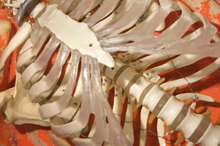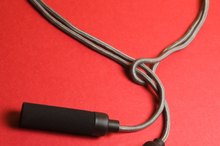Cardiac Precautions for Therapy
People with heart failure or who have recently had cardiac surgery must be vigilant when beginning an exercise therapy routine. The American Heart Association says that the goal of exercise training is to help the cardiac patient regain activity tolerance but to do so cautiously. Cardiac precautions are followed to ensure the heart is challenged enough through exercise to improve its ability to pump blood but to restrict overly aggressive activities that strain the heart and cause damage.
Vital Signs
Some of the easiest and most basic ways to monitor how hard the heart is working is by measuring blood pressure, abbreviated BP, and heart rate, or HR. With exercise, both blood pressure and heart rate are expected to increase, but a cardiac patient needs to closely monitor these measurements. According to MayoClinic.com, normal blood pressure is 120/80 mmHg and an average range for resting heart rate is between 60 and 100 beats per minute. In the initial stages of therapy, the patient is encouraged to work hard enough to increase both HR and BP so that he is working at 50 percent of maximum capacity. Working harder than this taxes the muscle of the heart too rigorously too early in the healing process.
- Some of the easiest and most basic ways to monitor how hard the heart is working is by measuring blood pressure, abbreviated BP, and heart rate, or HR.
- With exercise, both blood pressure and heart rate are expected to increase, but a cardiac patient needs to closely monitor these measurements.
Lifting Precautions
Should a Person with an Enlarged Heart Exercise?
Learn More
Most therapy programs for cardiac patients are designed around aerobic activities such as walking on a treadmill or riding a stationary bike. Eventually, resistance exercises are added to challenge the cardiovascular system. Weight should be gradually increased over time but limited to no more than 10 lbs. for the upper extremities. Lifting too much with the smaller musculature of the arms causes the heart to work at an unsafe intensity level.
- Most therapy programs for cardiac patients are designed around aerobic activities such as walking on a treadmill or riding a stationary bike.
- Lifting too much with the smaller musculature of the arms causes the heart to work at an unsafe intensity level.
Sternal Precautions
Cardiac patients with recent thoracic surgery need to be on guard in relation to sternal precautions. Because the sternum is opened during surgery and then re-approximated, physicians order sternal precautions to allow the bone to heal correctly. Until cleared by the surgeon, the patient should not use the arms for lifting of any kind, including pushing up from a chair with the hands. Additionally, pressure on the front of the chest should be prevented.
- Cardiac patients with recent thoracic surgery need to be on guard in relation to sternal precautions.
- Until cleared by the surgeon, the patient should not use the arms for lifting of any kind, including pushing up from a chair with the hands.
Perceived Exertion Scale
Arm Exercises With Sternal Precautions
Learn More
Many cardiac patients are taught to use the perceived exertion scale to measure how hard they feel they are working with various types of activities. The scale ranges from 6 to 20 and has been found to be an accurate predictor of actual heart rate levels during exercise, according to the CDC. Therapy that is performed at an intensity in the range of 9 to 11, or from “very light” to “light,” is considered safe. An intensity of 13, “somewhat hard,” or 15, “hard,” is too challenging and should be reduced quickly.
- Many cardiac patients are taught to use the perceived exertion scale to measure how hard they feel they are working with various types of activities.
- Therapy that is performed at an intensity in the range of 9 to 11, or from “very light” to “light,” is considered safe.
Red Flag Symptoms
The body’s demand for more oxygen with high levels of exercise causes the heart to try to pump harder and faster. This strain on the muscle of the heart can damage the organ further and in worst-case scenarios leads to a heart attack. The onset of symptoms such as significant shortness of breath, chest pain, dizziness, nausea or extreme fatigue are red flags that the heart is working too hard to try to supply the body with an adequate amount of blood. Exercise should be terminated immediately, and the symptoms should be reported to a physician for possible further medical evaluation.
- The body’s demand for more oxygen with high levels of exercise causes the heart to try to pump harder and faster.
- The onset of symptoms such as significant shortness of breath, chest pain, dizziness, nausea or extreme fatigue are red flags that the heart is working too hard to try to supply the body with an adequate amount of blood.
Related Articles
References
- “Circulation”; Exercise and Heart Failure: A Statement From the American Heart Association Committee on Exercise, Rehabilitation, and Prevention; I.L. Pina, C.S. Apstein, G.J. Balady, et. al.; March 2003
- MayoClinic.com: Blood Pressure Test
- MayoClinic.com: Fitness
- Centers for Disease Control and Prevention: Physical Activity for Everyone, Perceived Exertion (Borg Rating of Perceived Exertion)
- American Heart Association. What is Cardiovascular Disease?. Updated May 31, 2017.
- Centers for Disease Control and Prevention. Heart Disease Facts. Updated November 28, 2017.
- American Heart Association. About Peripheral Artery Disease (PAD). Updated October 31, 2016.
- Harvard Heart Letter. When an Infection Attacks the Heart. Harvard Health Publishing. Harvard Medical School. Published July 2016.
- American Heart Association. Symptoms, Diagnosis and Monitoring of Arrhythmia. Updated October 23, 2014.
- American Heart Association. Non-Invasive Tests and Procedures. Updated July 31, 2015.
- American Heart Association. Cardiac Medications. Updated July 31, 2015,
- Leening MJ, Berry JD, Allen NB. Lifetime Perspectives on Primary Prevention of Atherosclerotic Cardiovascular Disease. JAMA. April 12, 2016;315(14):1449-50. doi:10.1001/jama.2016.1654
Writer Bio
Karla Gambrill began writing health and wellness articles for LIVESTRONG.COM in 2010. She lives in central New Jersey and has worked in the health care field since 1994. Gambrill earned her Bachelor of Science in health sciences and a Master of Physical Therapy from the Philadelphia College of Pharmacy and Science.









